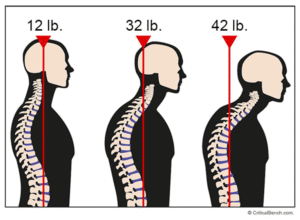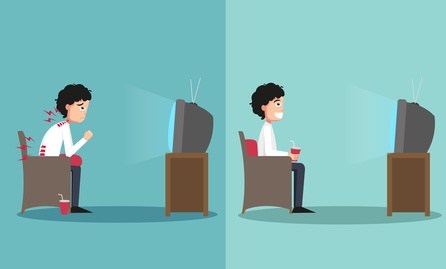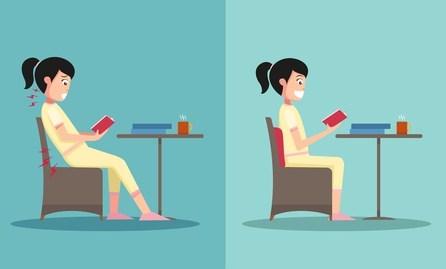Sitting is the New Smoking
by Meghann LaMarca, DPT
AzOPT Buckeye Doctor of Physical Therapy
Smoking comes with inherent risks everyone can agree upon – cancer, breathing, and coughing, to name a few. But sitting for long periods of time, especially behind a computer or the wheel of a car, can also create numerous health issues many do not consider. Sitting can not only affect your organs and body systems, but it also affects your muscles and posture.
Studies estimate that the average person sits 9.3 hours and sleeps 7.7 hours per day. And if you’re like most people, you’re probably looking down at your phone, looking down at your computer screen, or slouching while driving long distances. These positions lend themselves to poor posture, which leads to back and neck pain.
According to the National Institute of Arthritis and Musculoskeletal and Skin Diseases, back pain is one of America’s most common health problems. In fact, 1 out of 4 people experience back pain at least once in a three month period. The most common cause of lower back pain is postural stress. Things like sleeping in the wrong position, prolonged bending, heavy lifting, or even standing or lying down in a poor, rounded-back position can create postural stress.
 Similarly, habitually sitting in ways that cause tension and imbalance to your back and neck creates postural stress, which causes lower back pain. In fact, Cornell University Department of Ergonomics researchers found that up to 90% more pressure is applied to your lower back when you sit versus when you stand.
Similarly, habitually sitting in ways that cause tension and imbalance to your back and neck creates postural stress, which causes lower back pain. In fact, Cornell University Department of Ergonomics researchers found that up to 90% more pressure is applied to your lower back when you sit versus when you stand.
When sitting for an extended period, the hip flexors are in their shortened position which can prevent the glutes from firing, making them weak, and causing your hamstrings to overwork. This results in anterior pelvic tilt (APT), which is an excessive tilt of the pelvis. APT causes the abs to become underused and weak, tilting your pelvis even more, causing the sitter to look like they have a bigger stomach than they actually do. APT causes low back pain, poor movement mechanics (when you walk, do sports, and many activities), and reciprocal inhibition (when one muscle on one side of a joint relaxes because the opposing muscle is engaged).
Another symptom of poor posture is subsequent neck pain. The average human head weighs about 10-12 pounds. The small and somewhat delicate muscles, ligaments, bones, joints, nerves and discs in your neck are where most of the force and tension from that weight goes. When you look down at your phone to find your favorite song or text your friend, you significantly increase the relative weight of your head on your neck and generate as much as five times the force.
 Think about how much time you may spend on your devices. This extra force can be nearly constant, especially since this extra force and tension doesn’t cease when you look straight or sit up tall. To the contrary, forward head and downward head postures stick with you all day, and the increased forces from these positions create wear and tear on your neck.
Think about how much time you may spend on your devices. This extra force can be nearly constant, especially since this extra force and tension doesn’t cease when you look straight or sit up tall. To the contrary, forward head and downward head postures stick with you all day, and the increased forces from these positions create wear and tear on your neck.
So how can we fix this problem?
Workstation modifications:
If you sit at a desk all day, your neck and shoulders should be relaxed, and the screen should be in front of you and level with the top 1/3 of the screen. The chair should allow your feet to touch the floor and hips to bend slightly more than 90 degrees. If you use a telephone on a regular basis, avoid tilting your head to hold the phone. Better yet, try to get a headset that will allow you to hold your head upright. If you or your company allows, ask for a standing workstation. Standing, even for short periods throughout the day, has been proven to help alleviate or prevent sitting-caused back pain.
Take regular breaks:
If you sit for more than 1 hour during the day, it is recommended to get up every 30 minutes to stretch, walk and drink some water. We were not designed to sit. The body is a perpetual motion machine. When you’re sedentary, your muscles get less oxygen and nutrients from your blood. Try to keep your chest out and shoulders back, and pull your chin back so your head is centered over your shoulders while sitting and standing. Develop the habit of squeezing your shoulder blades together several times per day to train yourself not to slouch.
Exercise on a regular basis:
Besides walking, lifting weights and stretching can help battle neck and back pain. Lower impact activities such as yoga, Pilates or Tai Chi can also help reverse the damage done to your muscles by sitting. Regular exercises also has positive effects on your brain function and overall mood.
Attend physical therapy:
Scheduling an evaluation addresses specific issues when it comes to back pain. The main goal is simple – lengthen the short hip flexors, retrain the glutes and hamstrings, and strengthen the abs to help pull the pelvis into place. Your physical therapist will conduct a full examination including looking at your posture, muscle strength, flexibility and range of motion. We encourage you to walk and stretch. Additionally, finding an exercise that strengthens your core and teaches you to use those muscles properly can be really helpful for many people to get rid of their low back pain.
In summary, sitting can cause bad things to your body in regard to health and pain. Get moving as much as you can. If your back or neck pain do not resolve after trying the above activities, please give us a call. We are here to help decrease your pain and improve your quality of life.









